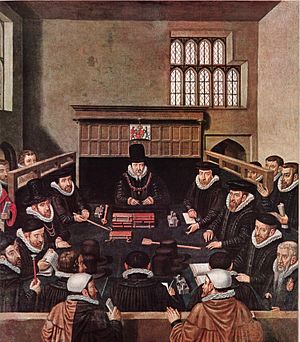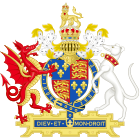Court of Wards and Liveries facts for kids

Quick facts for kids Court of Wards Act 1540 |
|
|---|---|
| Act of Parliament | |

|
|
| Citation | 32 Hen. 8. c. 46 |
| Wards and Liveries Act 1541 | |
|---|---|
| Act of Parliament | |

|
|
| Citation | 33 Hen. 8. c. 22 |
The Court of Wards and Liveries was a special court in England. It was set up by King Henry VIII. Its main job was to manage a system of payments called "feudal dues." These were payments owed to the king by his most important landowners.
Besides collecting money, the court also handled "wardship" and "livery" matters. Wardship meant the king took care of young heirs who had lost their parents. Livery was when these heirs finally took control of their lands.
The court was officially created between 1540 and 1541. This happened through two laws passed by Parliament. These were the Court of Wards Act of 1540 and the Wards and Liveries Act of 1541.
A famous person, William Cecil, became the Master of the Court in 1561. He was in charge of raising orphaned heirs to noble families. He also managed their lands until they were old enough to take over.
In 1610, King James I tried to make a deal. He wanted Parliament to give him a regular income. In return, he would get rid of the Court of Wards, which many people disliked. The deal didn't work out.
The Court of Wards and Liveries lost its main purpose in 1646. This was during the English Civil War. The Long Parliament ended the old feudal system of land ownership. The court was officially closed down in 1660. This happened after the monarchy was brought back. The law that ended it was called the Tenures Abolition Act 1660.
Contents
How the Court of Wards Started
Kings in England had old rights to control the lands of their most important landowners. These rights were called "feudal incidents." One of these was wardship. This meant the king could take control of the lands of young heirs whose fathers had died.
King Henry VIII of England wanted to make sure he got all the money he was owed. So, in 1535, he supported a law called the Statute of Uses. This law made it harder for landowners to avoid their payments to the king.
When a landowner died, the king had the right to all the money from their estate. This was true until the heir became 21 years old. If the heir was a girl, she could take control at 14. The king usually sold these wardships to the person who offered the most money. Sometimes, he gave them away for free to a favorite person as a reward.
When an heir turned 21, a special check was done. This was called a "proof of age inquisition." Important local men would confirm that the heir was indeed 21. After this, the king would order the land to be given back to the heir.
Here is an example from 1495:
William Martyn and William Twynyho were given the job of looking after the lands of John Trenchard. They also had to care for his son and heir, Thomas Trenchard.
Finding Wardships for the King
When a major landowner died, a local official called an "escheator" had to investigate. They would hold an "inquisition post mortem." This report went to the Court of Chancery. It listed the size and location of the lands. It also noted the payments owed to the king.
The report also named the deceased person and their heir, along with their ages. A copy was sent to the Exchequer. After 1540, a copy also went to the Court of Wards and Liveries. This helped the king keep track of all the lands and heirs.
Kings Get More Money from Wardships
By the 1400s, the system for collecting these royal payments wasn't working well. But when King Henry VII came to power in 1485, things changed. He wanted to fill the royal treasury. So, he made sure these old rights were used fully.
New officials were hired to find possible royal wardships. They would actively search and even spy to find them. In each county, there were people in charge of the king's wards. These included a master, a receiver-general, and an auditor.
People who provided information about new crown wards were paid well. A "Master of the King's Wards" was appointed in 1503. This person oversaw all royal wardships. They managed the lands and money of the wards. They also sold wardships that the king didn't want to keep. The money collected went directly to the king's private funds.
At first, the Master had to report to the king four times a year. In 1531, this changed. They had to report to general surveyors instead.
Important Masters of Wards
- Sir John Hussey (1503–1513)
- Sir Thomas Lovell (1513–1520)
- Sir Richard Weston (1518–1526)
- Sir Edward Belknap (1520–1521)
- Sir Thomas Englefield (1526–1534)
- Sir William Paulet (1526–1540)
Creating the Court of Wards
In 1540, the old "Master of the King's Wards" office was replaced. The new "Court of Wards" took complete control. It managed all wards and their lands. This idea came from the successful Court of Augmentations, set up in 1536.
The new court had its own official seal. It met four times a year. Other important officials included a surveyor, an attorney, a receiver-general, and two auditors.
Joining with the Office of Liveries
There was also an "Office of Surveyor of the King's Liveries." This office existed from 1514 to 1542. In 1542, it joined with the Court of Wards. This created the "King's Court of Wards and Liveries."
Important Masters of the Court of Wards and Liveries
- Sir William Paulet (1540–1554)
- Sir Francis Eaglefield (1554–1558)
- Sir Thomas Parry (c.1558–c.1561)
- Lord Burghley (1561–1598)
- Robert Cecil (1599–1612)
- George Carew (1612)
- Walter Cope (1612–1614)
- Sir William Knollys (1614–1618)
- Lionel Cranfield (1619–1623)
- Sir Robert Naunton (1624–1635)
- Francis Cottington (1635–1641)
- William, Viscount Saye and Sele (1641–?)
See also
- William Paulet, 1st Marquess of Winchester, the first Master of the Court

